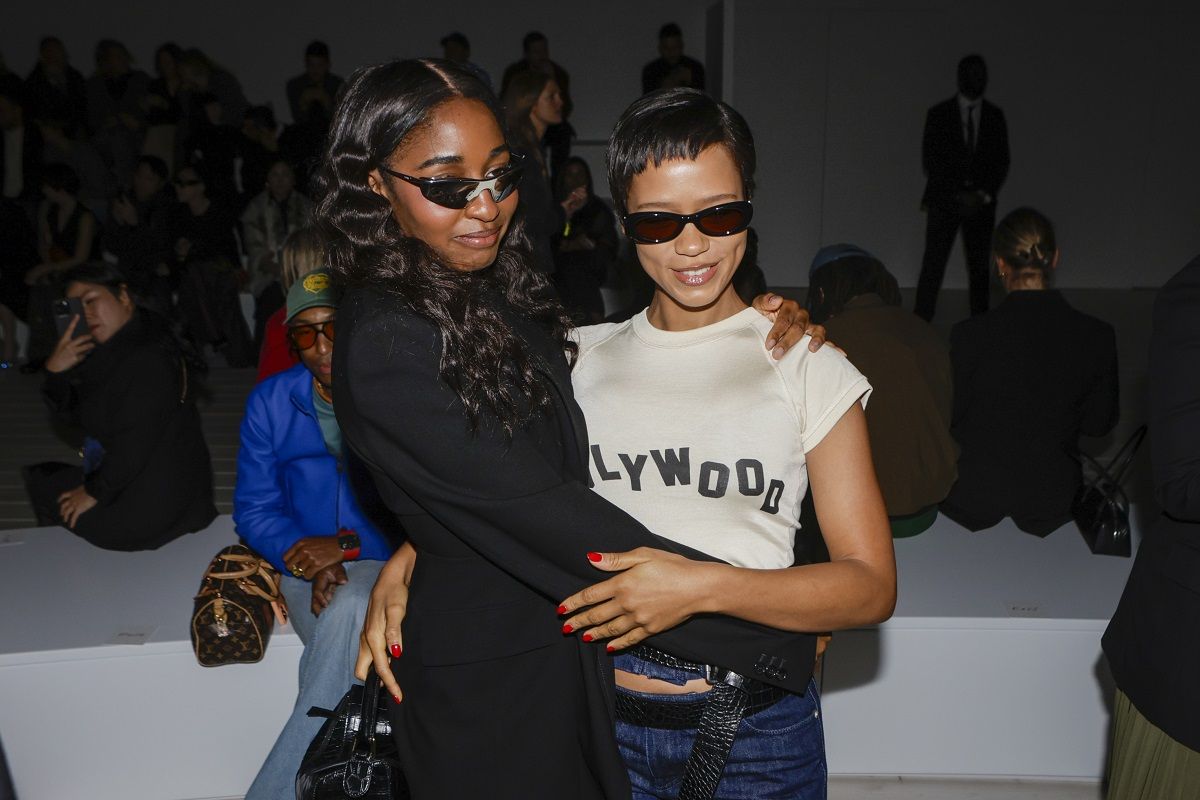
Ayo Edebiri, left, hugs Taylor Russell at the Loewe show.
13:35 JST, October 2, 2024
PARIS – As big as fashion is – and it’s never been bigger – it’s really behind the times.
People like to say that fashion is popular culture, but it’s neither as forward thinking in problem-solving as architecture, as provocative as visual art or as relevant as pop music, where a slate of eccentric women are staging a sugary assault on conservative values so potent that we’re begging them to weigh in on politics.
Mostly, fashion is a rehash of the same safe ideas.
There is one exception to this standard, and that is Jonathan Anderson, the creative director of Loewe for the past decade, where he showed his latest collection on Friday, as well as his own brand, JW Anderson.
He is today’s consummate fashion designer. He understands celebrity: In Friday’s front row were Ayo Edebiri, Greta Lee, Josh O’Connor, Rob Lowe, Daniel Craig and his wife, Rachel Weisz. They’re not the most obvious people, but rather the most interesting. (He put Maggie Smith, who recently died at 89, in a campaign late last year.) He knows how to merchandise: His runway show was packed with bad-ass shield sunglasses, funky high-top sneakers, a clown-shoe-like brogue and nifty handbags.
But most of all, he does what so few of his peers can do: He has courageous ideas, and he gives them to us at an extraordinary level of execution. Anderson said he wanted to make a show all about reduction, and it was leanly styled, with each of the looks having very few bells and whistles. He opened with gowns – wisps of printed floral fabrics hung on askew crinoline frames. The dresses swayed and bobbed with awkward, strange beauty, puckering the collection again and again between other looks. He showed the perfect suit, with a bulbous, luxurious pool of cuff and swaggy trousers, yet with the arms precisely narrow in the back. He gave us T-shirts made of feathers printed with the visages of Chopin and Mozart. Minidresses made of mother of pearl (!), worn with that silly brogue.
His 57-look collection was like a smack in the face to the rest of fashion: Wake up and give us ideas about the world we live in today.
The pacing and environment, a big white box with a Tracey Emin bird perched haughtily on a post in the middle, meant you could really feel the wow of his techniques and ponder what this was all about. It was at once concise and expansive.
-
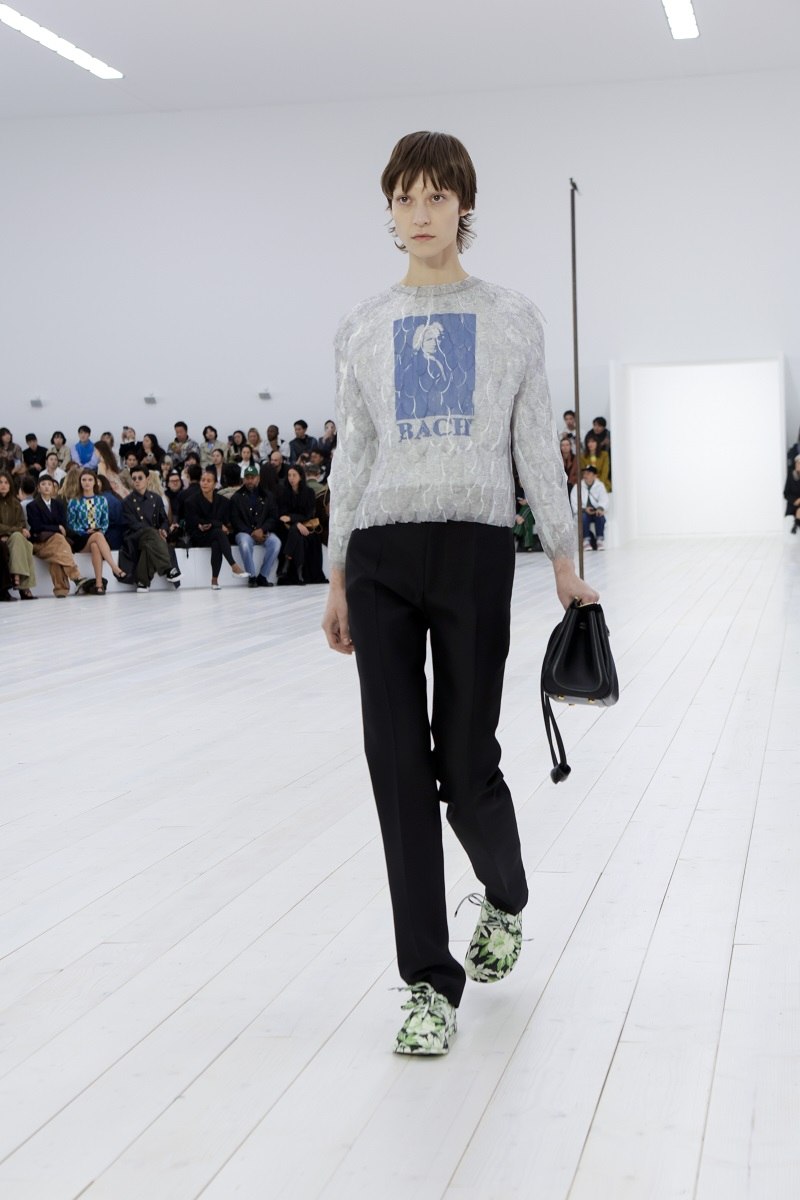
Jonas Gustavsson for The Washington Post
A Bach T-shirt made of feathers, with a normie trouser. -
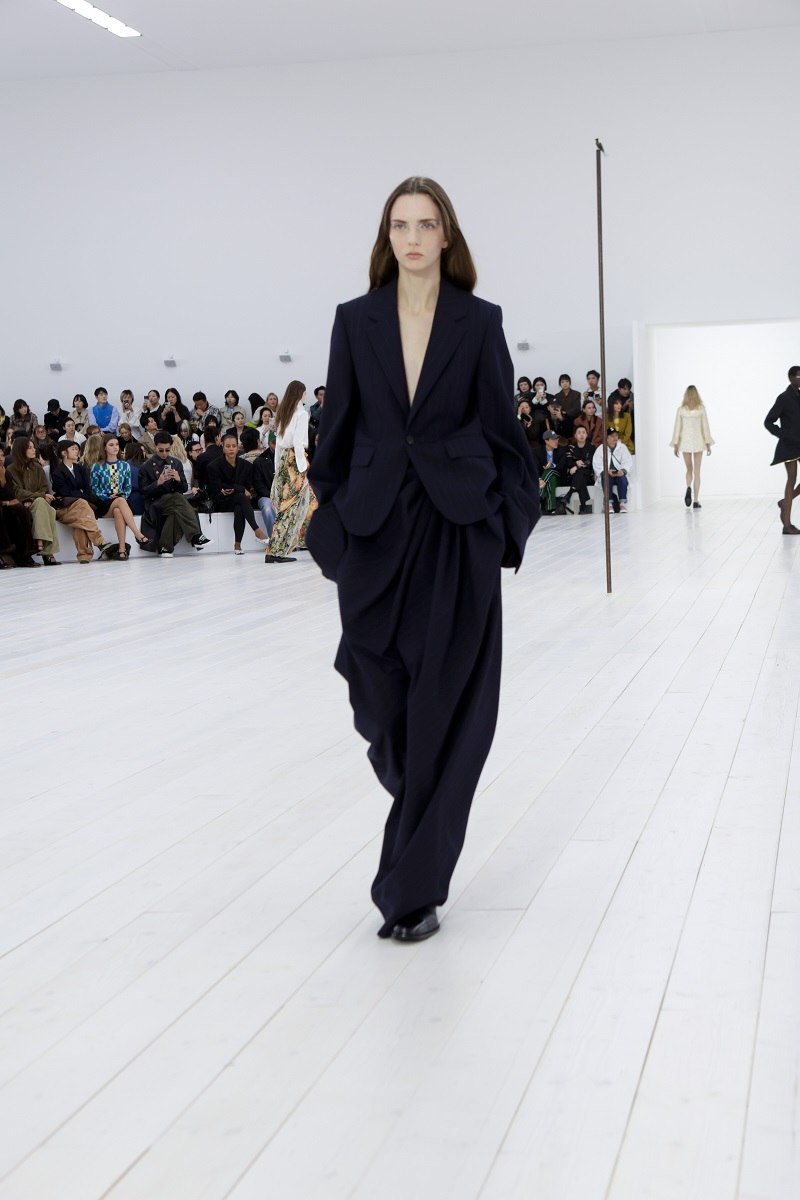
Jonas Gustavsson for The Washington Post
An exceedingly elegant suit. -

Jonas Gustavsson for The Washington Post
A minidress made of mother of pearl. -
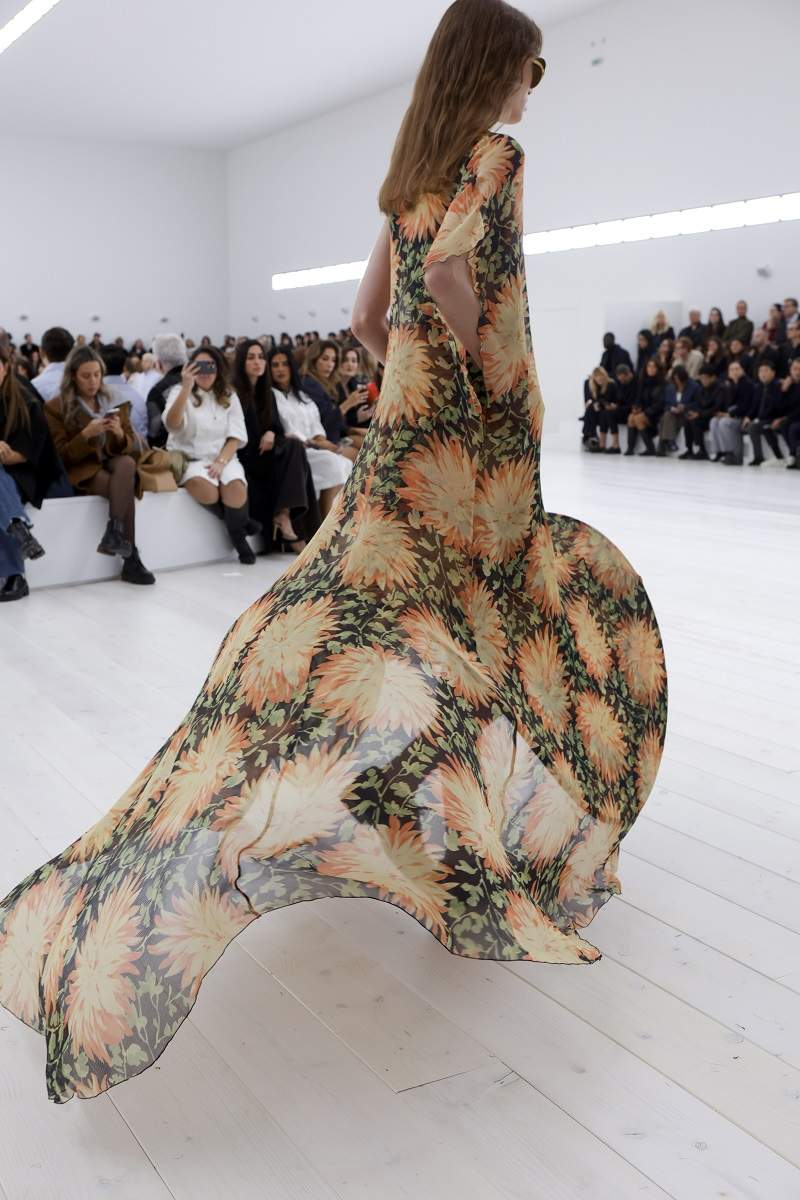
Jonas Gustavsson for The Washington Post
History floats by. -

Jonas Gustavsson for The Washington Post
A lacy look at Yohji Yamamoto. -

Rachel Tashjian/The Washington Post
Sensuous difference at Rick Owens. -


Jonas Gustavsson for The Washington Post
In the clouds at Comme des Garcons. -
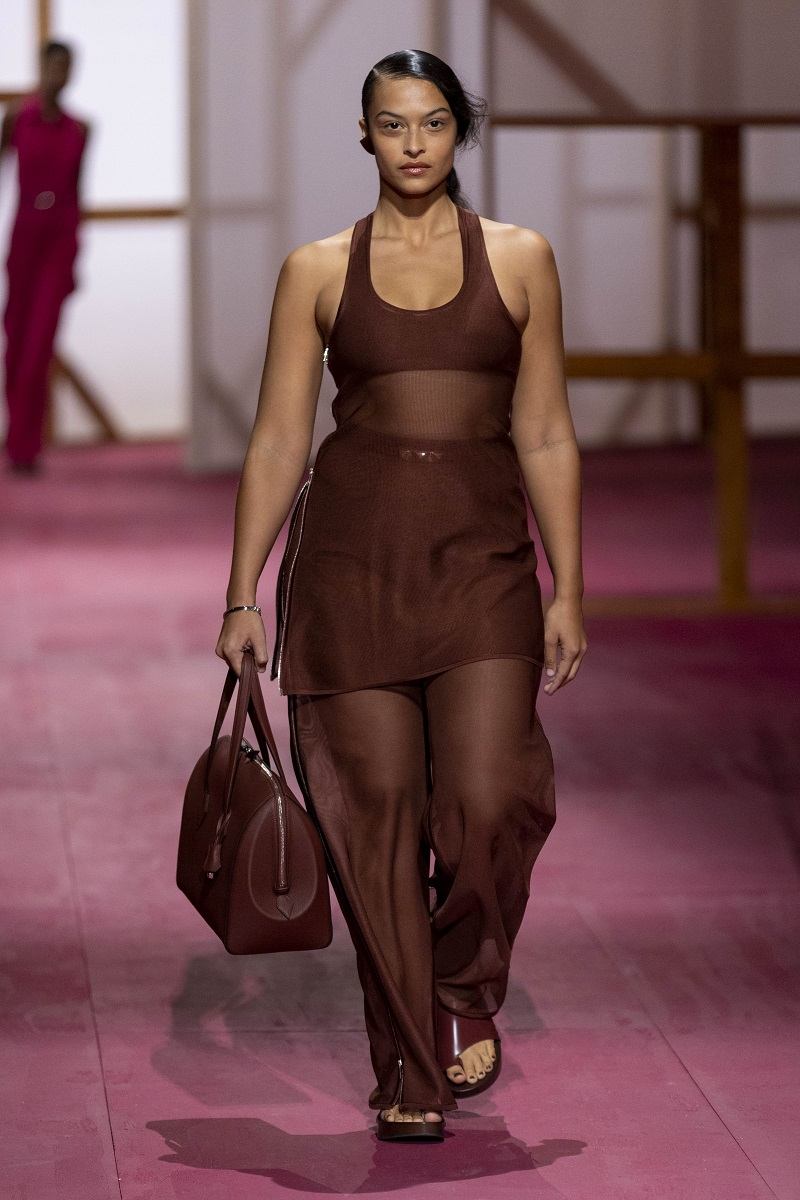

Jonas Gustavsson for The Washington Post
Sheer and sexy but not at all tawdry.
So what was it, indeed, all about?
I saw a collection attacking the exact question that fashion designers are wrestling with but that few take up the challenge to answer: What does “newness” really mean? You can’t help but hang on to what is old – those crinolines, the turn-of-the-century bobble of those suit cuffs, the big canon of culture (Bach and Van Gogh, for goodness sake!) breathing down everyone’s necks – so you end up yanking obsolete stuff into your quest for modernity. Here were the skeletons of fashions history, the challenges of using old materials like feathers in new ways and even punchlines about hemlines, those archaic barometers of fashion change. (The minidresses were ridiculously short, and several coats had hems that flipped up a la in-medias-Monroe as if to say, “Is this new?”)
This is a message that goes deeper, or at least bigger and broader, than fashion. How and why to make something new? Should we learn from the past or draw a line that separates us from its horrors, its mistakes and grave embarrassments? Was the past in fact better? How do we honor our previous icons? These are the questions that every creative person (and even many a politician) is trying to work out now.
Anderson looked particularly emotional, and the chatter at every dinner party and between shows has been that he is headed to a bigger brand. (LVMH, which owns Loewe, also runs Louis Vuitton, Celine and Dior. The top job at Chanel is also open, and Kering, which owns Gucci and Balenciaga, is in need of some snap.) Anderson should absolutely be at a bigger brand, one where he can really set the agenda and bring fashion into competition with other mediums with his taste, his creativity and, most of all, his sense of urgency.
Not everyone has to be influential at the level or breadth of Anderson. We need designers who speak to their cultivated audience, like Yohji Yamamoto, who reminded us with his scraps of lace and embellishments that, at 80, you can have gorgeous new ideas. (This is what actors should be wearing on the red carpet!)
And not all such cult designers hit home runs this season: Rick Owens intended his collection to be an exercise in inclusivity, with the cast made up of professors and students from local fashion schools and friends of the brand, walking in groups wearing the same outfits. But the vision was disrupted by the difficult shoes. While it was a reminder of how flattering Owens’s special clothes are on so many types of bodies, it is unfair to tell people they are beautiful and then make them walk in uncomfortable platforms.
Comme des Garçons was a smash. Rei Kawakubo, the high priestess of cipher clothes, gives us wearable sculptures that turn every woman into an amateur philosopher. Maybe the best thing about fashion month – the exhausting parade of shows that spans four cities for a month twice a year – is that it’s an extended period in which ideas are presented to (mostly) women, and (mostly) women are asked what they think. How rare and groovy is that?
Kawakubo’s bulbous garments of trash bags – and even what appeared to be prints of trash and the tent cities that have popped up all around the world amid a global homelessness crisis – that seemed to morph into shelters and then clouds, seemed like a journey of the designer’s continued frustration with the process of creating clothes, with the added baggage (literally) of there being so much stuff today and so few clothes that really address the world we live in. “Confronting an uncertain world with air and transparency could signify a kind of hope” was the only note offered on the show.
The same with Hermès, where Nadège Vanhee is just on fire. After a decade at the house, something has been unleashed in Vanhee, and her see-through zip-up trousers and skirts, worn with leather trenches and anoraks, were beautiful and genuinely cool whereas most big-time fashion labels are cheesy. She has a way of making sexy clothes without a trace of vulgarity – totally confident pieces that have what she and Kawakubo share makes them so great: a sense of wit.
"News Services" POPULAR ARTICLE
-

American Playwright Jeremy O. Harris Arrested in Japan on Alleged Drug Smuggling
-

Japan’s Nikkei Stock Average as JGB Yields, Yen Rise on Rate-Hike Bets
-

Japan’s Nikkei Stock Average Licks Wounds after Selloff Sparked by BOJ Hike Bets (UPDATE 1)
-

Japan’s Nikkei Stock Average Buoyed by Stable Yen; SoftBank’s Slide Caps Gains (UPDATE 1)
-

Japanese Bond Yields Zoom, Stocks Slide as Rate Hike Looms
JN ACCESS RANKING
-

Keidanren Chairman Yoshinobu Tsutsui Visits Kashiwazaki-Kariwa Nuclear Power Plant; Inspects New Emergency Safety System
-

Imports of Rare Earths from China Facing Delays, May Be Caused by Deterioration of Japan-China Relations
-

University of Tokyo Professor Discusses Japanese Economic Security in Interview Ahead of Forum
-

Japan Pulls out of Vietnam Nuclear Project, Complicating Hanoi’s Power Plans
-

Govt Aims to Expand NISA Program Lineup, Abolish Age Restriction



























